trailer TOYOTA YARIS 2014 Owners Manual
[x] Cancel search | Manufacturer: TOYOTA, Model Year: 2014, Model line: YARIS, Model: TOYOTA YARIS 2014Pages: 712, PDF Size: 30.2 MB
Page 3 of 712
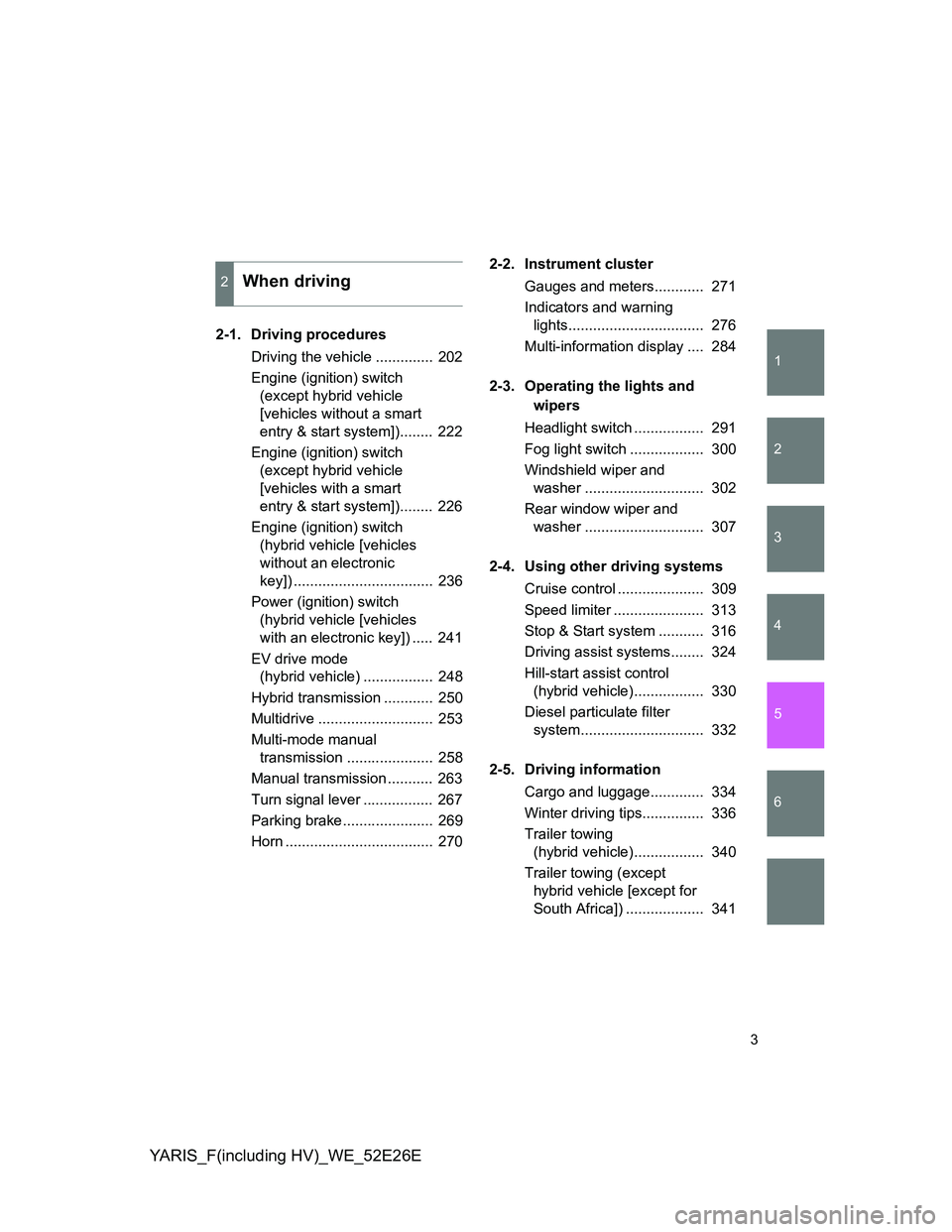
1
2
3
4
5
6
YARIS_F(including HV)_WE_52E26E
3
2-1. Driving procedures
Driving the vehicle .............. 202
Engine (ignition) switch
(except hybrid vehicle
[vehicles without a smart
entry & start system])........ 222
Engine (ignition) switch
(except hybrid vehicle
[vehicles with a smart
entry & start system])........ 226
Engine (ignition) switch
(hybrid vehicle [vehicles
without an electronic
key]) .................................. 236
Power (ignition) switch
(hybrid vehicle [vehicles
with an electronic key]) ..... 241
EV drive mode
(hybrid vehicle) ................. 248
Hybrid transmission ............ 250
Multidrive ............................ 253
Multi-mode manual
transmission ..................... 258
Manual transmission ........... 263
Turn signal lever ................. 267
Parking brake...................... 269
Horn .................................... 2702-2. Instrument cluster
Gauges and meters............ 271
Indicators and warning
lights................................. 276
Multi-information display .... 284
2-3. Operating the lights and
wipers
Headlight switch ................. 291
Fog light switch .................. 300
Windshield wiper and
washer ............................. 302
Rear window wiper and
washer ............................. 307
2-4. Using other driving systems
Cruise control ..................... 309
Speed limiter ...................... 313
Stop & Start system ........... 316
Driving assist systems........ 324
Hill-start assist control
(hybrid vehicle)................. 330
Diesel particulate filter
system.............................. 332
2-5. Driving information
Cargo and luggage............. 334
Winter driving tips............... 336
Trailer towing
(hybrid vehicle)................. 340
Trailer towing (except
hybrid vehicle [except for
South Africa]) ................... 341
2When driving
Page 201 of 712
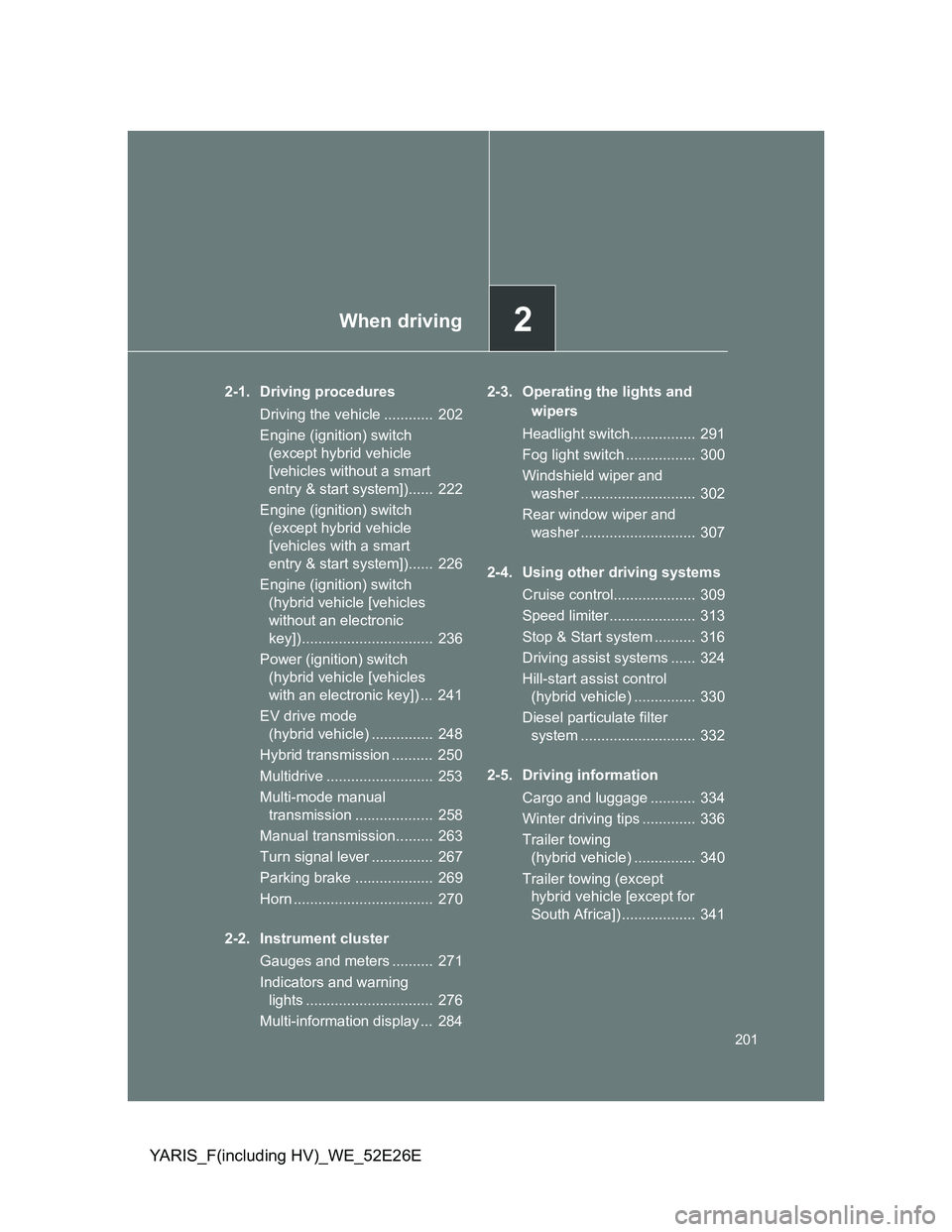
2When driving
201
YARIS_F(including HV)_WE_52E26E
2-1. Driving procedures
Driving the vehicle ............ 202
Engine (ignition) switch
(except hybrid vehicle
[vehicles without a smart
entry & start system])...... 222
Engine (ignition) switch
(except hybrid vehicle
[vehicles with a smart
entry & start system])...... 226
Engine (ignition) switch
(hybrid vehicle [vehicles
without an electronic
key]) ................................ 236
Power (ignition) switch
(hybrid vehicle [vehicles
with an electronic key]) ... 241
EV drive mode
(hybrid vehicle) ............... 248
Hybrid transmission .......... 250
Multidrive .......................... 253
Multi-mode manual
transmission ................... 258
Manual transmission......... 263
Turn signal lever ............... 267
Parking brake ................... 269
Horn .................................. 270
2-2. Instrument cluster
Gauges and meters .......... 271
Indicators and warning
lights ............................... 276
Multi-information display ... 2842-3. Operating the lights and
wipers
Headlight switch................ 291
Fog light switch ................. 300
Windshield wiper and
washer ............................ 302
Rear window wiper and
washer ............................ 307
2-4. Using other driving systems
Cruise control.................... 309
Speed limiter ..................... 313
Stop & Start system .......... 316
Driving assist systems ...... 324
Hill-start assist control
(hybrid vehicle) ............... 330
Diesel particulate filter
system ............................ 332
2-5. Driving information
Cargo and luggage ........... 334
Winter driving tips ............. 336
Trailer towing
(hybrid vehicle) ............... 340
Trailer towing (except
hybrid vehicle [except for
South Africa]) .................. 341
Page 207 of 712
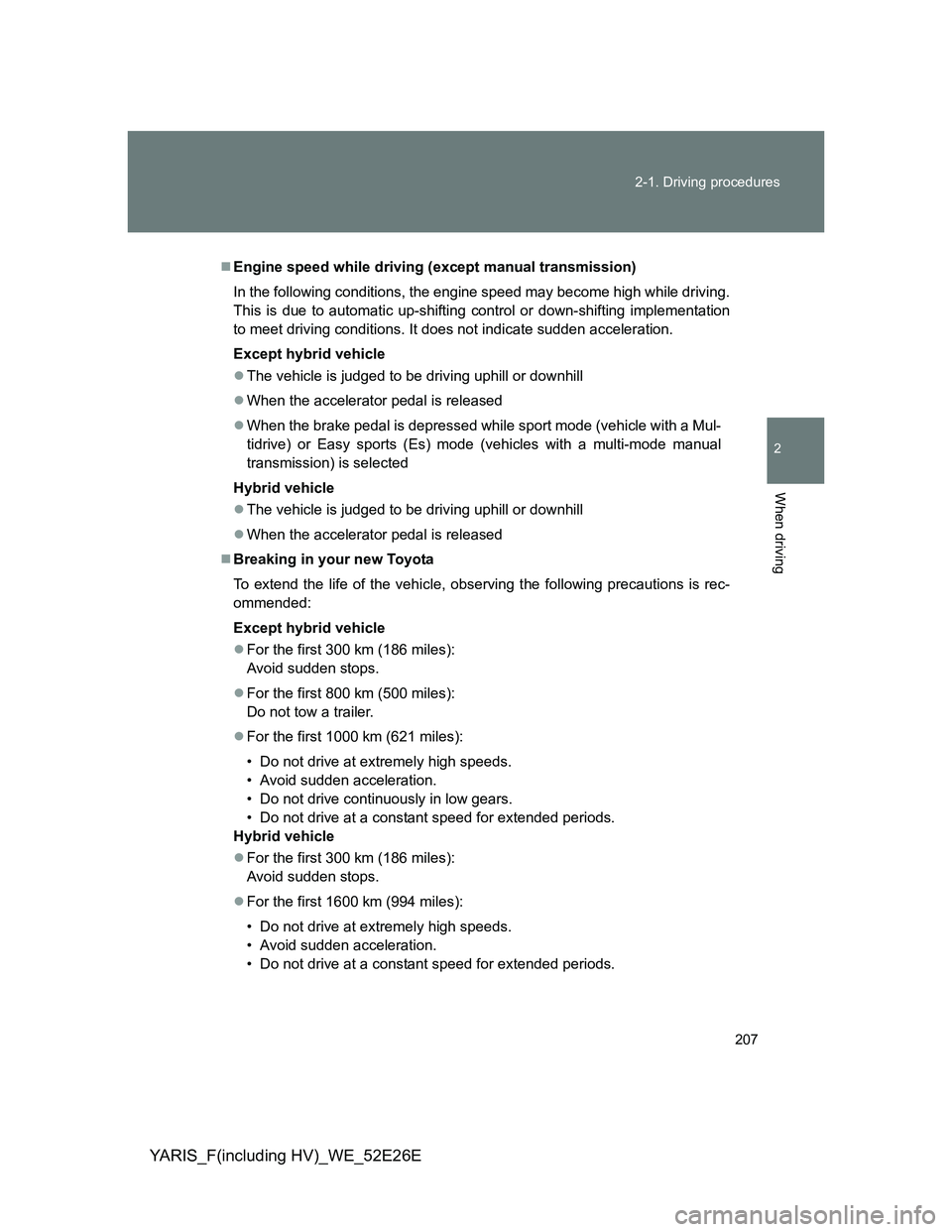
207 2-1. Driving procedures
2
When driving
YARIS_F(including HV)_WE_52E26E
Engine speed while driving (except manual transmission)
In the following conditions, the engine speed may become high while driving.
This is due to automatic up-shifting control or down-shifting implementation
to meet driving conditions. It does not indicate sudden acceleration.
Except hybrid vehicle
The vehicle is judged to be driving uphill or downhill
When the accelerator pedal is released
When the brake pedal is depressed while sport mode (vehicle with a Mul-
tidrive) or Easy sports (Es) mode (vehicles with a multi-mode manual
transmission) is selected
Hybrid vehicle
The vehicle is judged to be driving uphill or downhill
When the accelerator pedal is released
Breaking in your new Toyota
To extend the life of the vehicle, observing the following precautions is rec-
ommended:
Except hybrid vehicle
For the first 300 km (186 miles):
Avoid sudden stops.
For the first 800 km (500 miles):
Do not tow a trailer.
For the first 1000 km (621 miles):
• Do not drive at extremely high speeds.
• Avoid sudden acceleration.
• Do not drive continuously in low gears.
• Do not drive at a constant speed for extended periods.
Hybrid vehicle
For the first 300 km (186 miles):
Avoid sudden stops.
For the first 1600 km (994 miles):
• Do not drive at extremely high speeds.
• Avoid sudden acceleration.
• Do not drive at a constant speed for extended periods.
Page 312 of 712
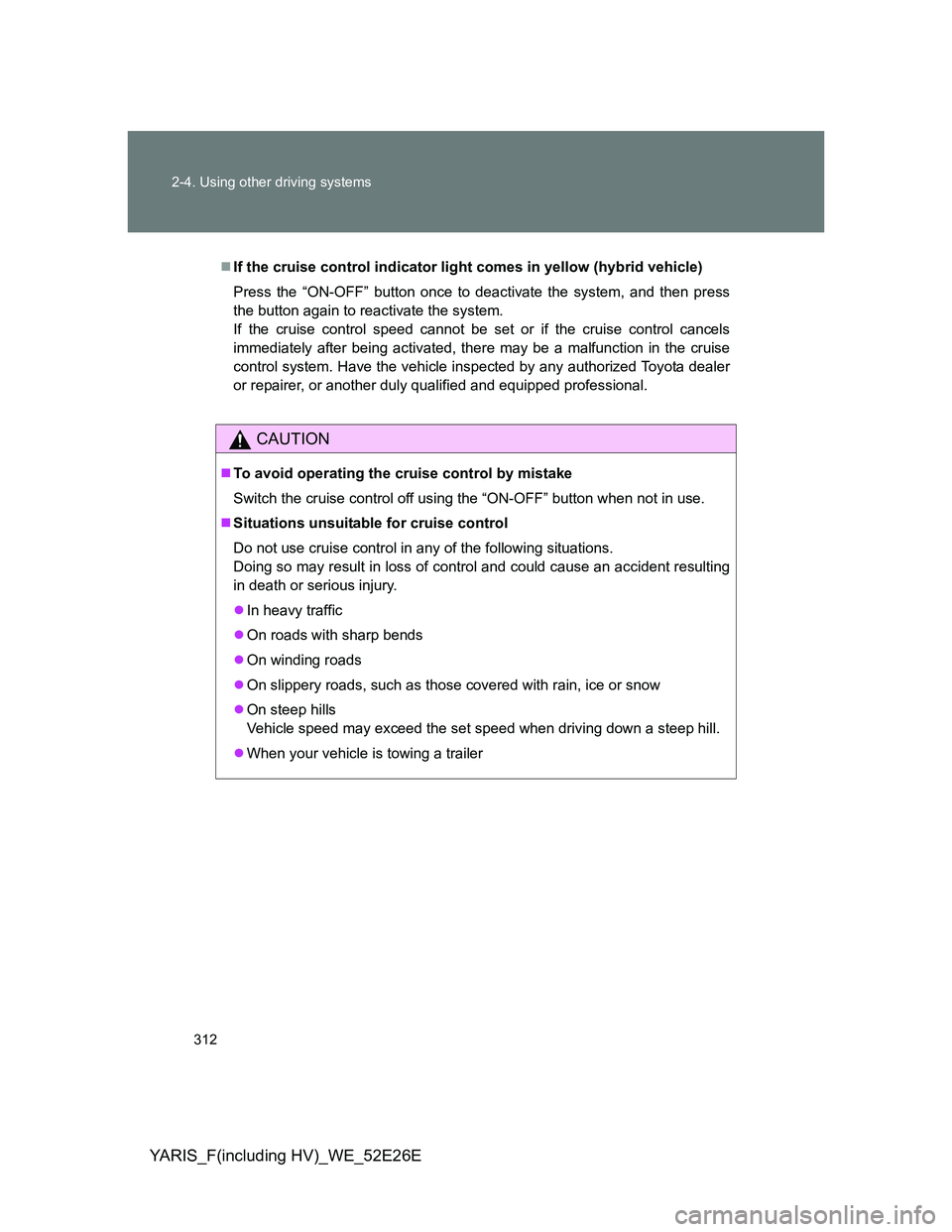
312 2-4. Using other driving systems
YARIS_F(including HV)_WE_52E26E
If the cruise control indicator light comes in yellow (hybrid vehicle)
Press the “ON-OFF” button once to deactivate the system, and then press
the button again to reactivate the system.
If the cruise control speed cannot be set or if the cruise control cancels
immediately after being activated, there may be a malfunction in the cruise
control system. Have the vehicle inspected by any authorized Toyota dealer
or repairer, or another duly qualified and equipped professional.
CAUTION
To avoid operating the cruise control by mistake
Switch the cruise control off using the “ON-OFF” button when not in use.
Situations unsuitable for cruise control
Do not use cruise control in any of the following situations.
Doing so may result in loss of control and could cause an accident resulting
in death or serious injury.
In heavy traffic
On roads with sharp bends
On winding roads
On slippery roads, such as those covered with rain, ice or snow
On steep hills
Vehicle speed may exceed the set speed when driving down a steep hill.
When your vehicle is towing a trailer
Page 315 of 712
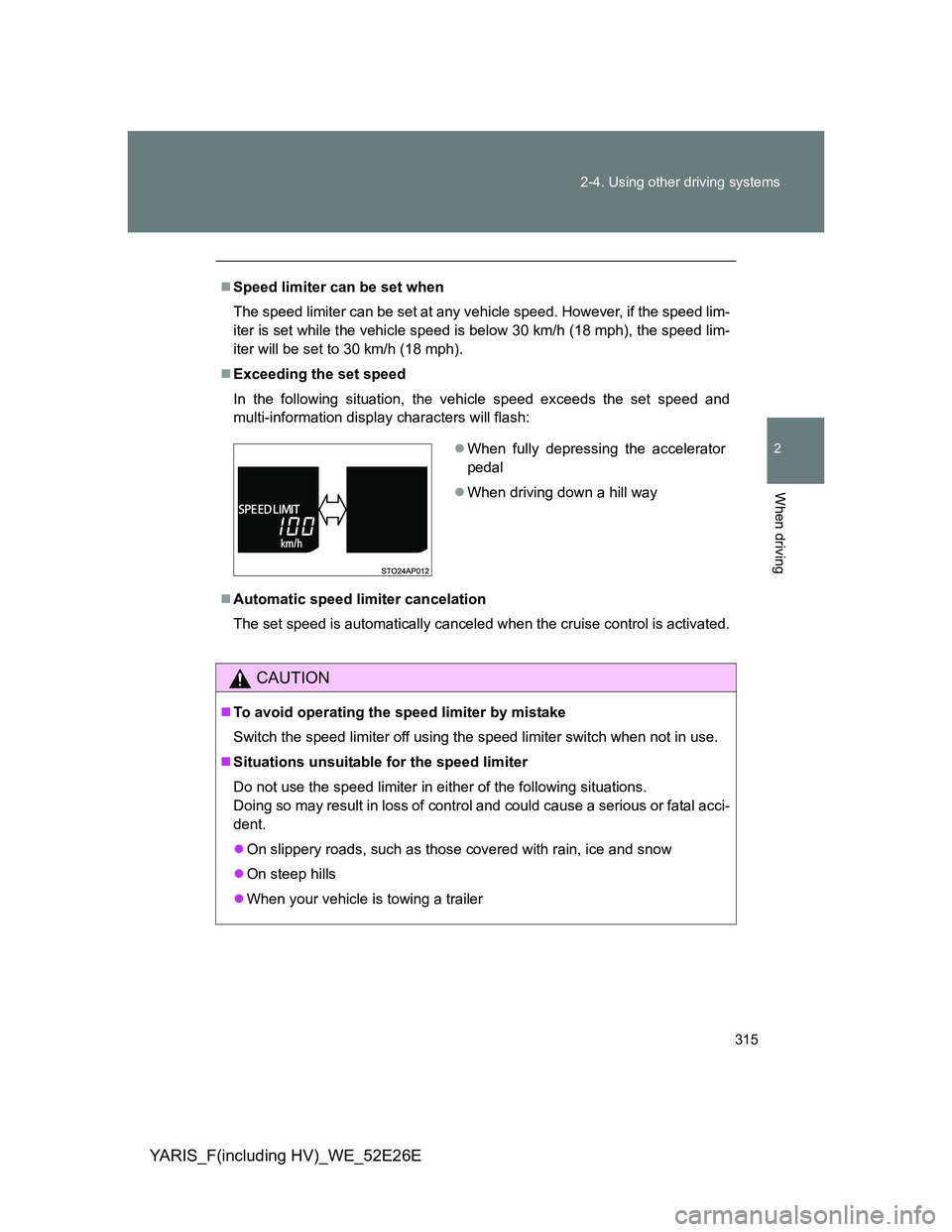
315 2-4. Using other driving systems
2
When driving
YARIS_F(including HV)_WE_52E26E
Speed limiter can be set when
The speed limiter can be set at any vehicle speed. However, if the speed lim-
iter is set while the vehicle speed is below 30 km/h (18 mph), the speed lim-
iter will be set to 30 km/h (18 mph).
Exceeding the set speed
In the following situation, the vehicle speed exceeds the set speed and
multi-information display characters will flash:
Automatic speed limiter cancelation
The set speed is automatically canceled when the cruise control is activated.
CAUTION
To avoid operating the speed limiter by mistake
Switch the speed limiter off using the speed limiter switch when not in use.
Situations unsuitable for the speed limiter
Do not use the speed limiter in either of the following situations.
Doing so may result in loss of control and could cause a serious or fatal acci-
dent.
On slippery roads, such as those covered with rain, ice and snow
On steep hills
When your vehicle is towing a trailer
When fully depressing the accelerator
pedal
When driving down a hill way
Page 340 of 712
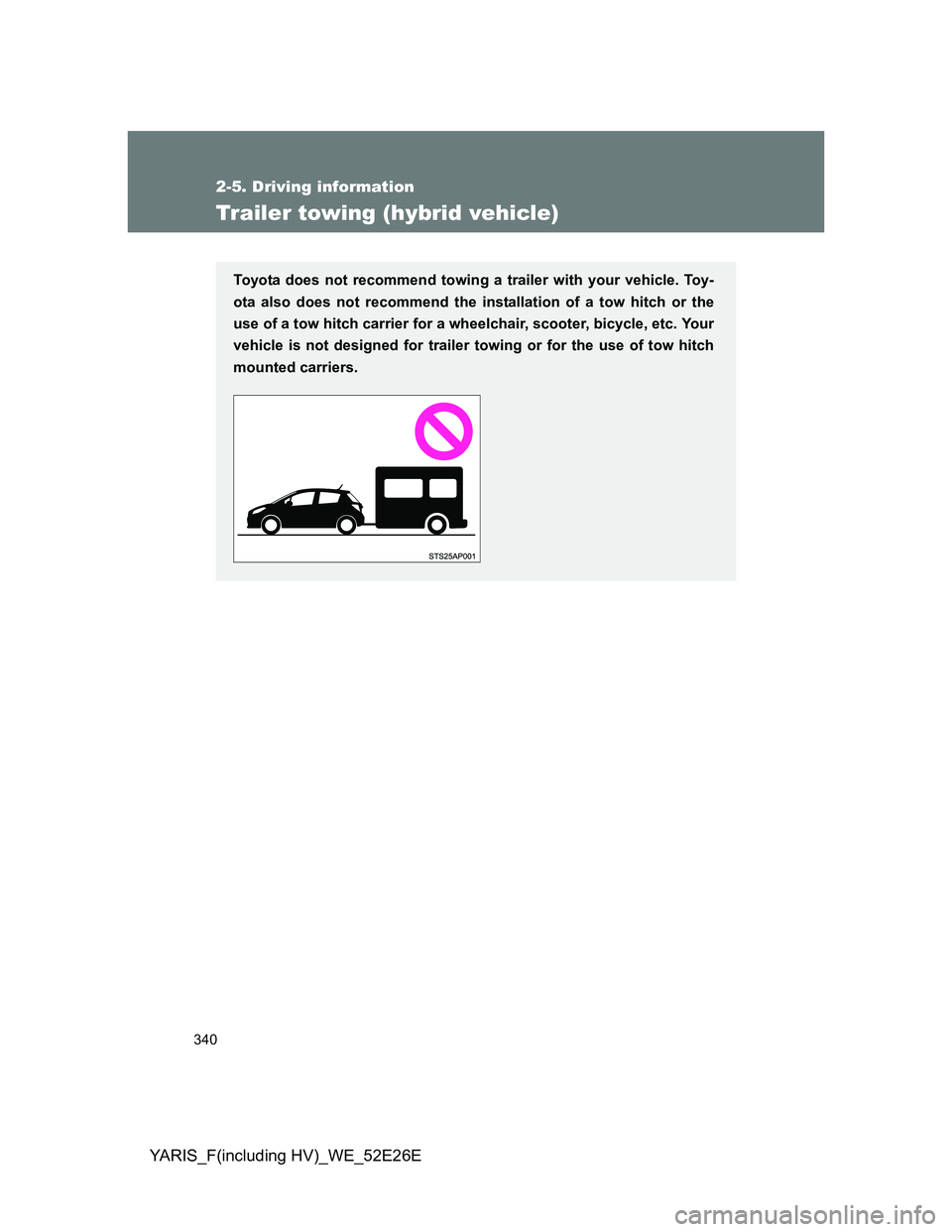
340
2-5. Driving information
YARIS_F(including HV)_WE_52E26E
Trailer towing (hybrid vehicle)
Toyota does not recommend towing a trailer with your vehicle. Toy-
ota also does not recommend the installation of a tow hitch or the
use of a tow hitch carrier for a wheelchair, scooter, bicycle, etc. Your
vehicle is not designed for trailer towing or for the use of tow hitch
mounted carriers.
Page 341 of 712
![TOYOTA YARIS 2014 Owners Manual 341
2-5. Driving information
2
When driving
YARIS_F(including HV)_WE_52E26E
Trailer towing (except hybrid vehicle [except for South Africa])
Your vehicle is designed primarily as a passenger carrying TOYOTA YARIS 2014 Owners Manual 341
2-5. Driving information
2
When driving
YARIS_F(including HV)_WE_52E26E
Trailer towing (except hybrid vehicle [except for South Africa])
Your vehicle is designed primarily as a passenger carrying](/img/14/49158/w960_49158-340.png)
341
2-5. Driving information
2
When driving
YARIS_F(including HV)_WE_52E26E
Trailer towing (except hybrid vehicle [except for South Africa])
Your vehicle is designed primarily as a passenger carrying vehicle.
Towing a trailer will have an adverse effect on handling, perfor-
mance, braking, durability, and fuel consumption. Your safety and
satisfaction depend on the proper use of correct equipment and cau-
tious driving habits. For your safety and the safety of others, do not
overload the vehicle or trailer.
To tow a trailer safely, use extreme care and drive the vehicle in
accordance with the trailer’s characteristics and operating condi-
tions.
Toyota warranties do not apply to damage or malfunction caused by
towing a trailer for commercial purposes.
Ask your local authorized Toyota dealer or repairer, or another duly
qualified and equipped professional, for further details before tow-
ing, as there are additional legal requirements in some countries.
Weight limits
Check the allowable towing capacity, GVM (Gross Vehicle
Mass), MPAC (Maximum Permissible Axle Capacity), and per-
missible drawbar load before towing. (P. 660)
Towing hitch/bracket
Toyota recommends the use of the Toyota hitch/bracket for your
vehicle. Other products of a suitable nature and comparable
quality may also be used.
Page 342 of 712
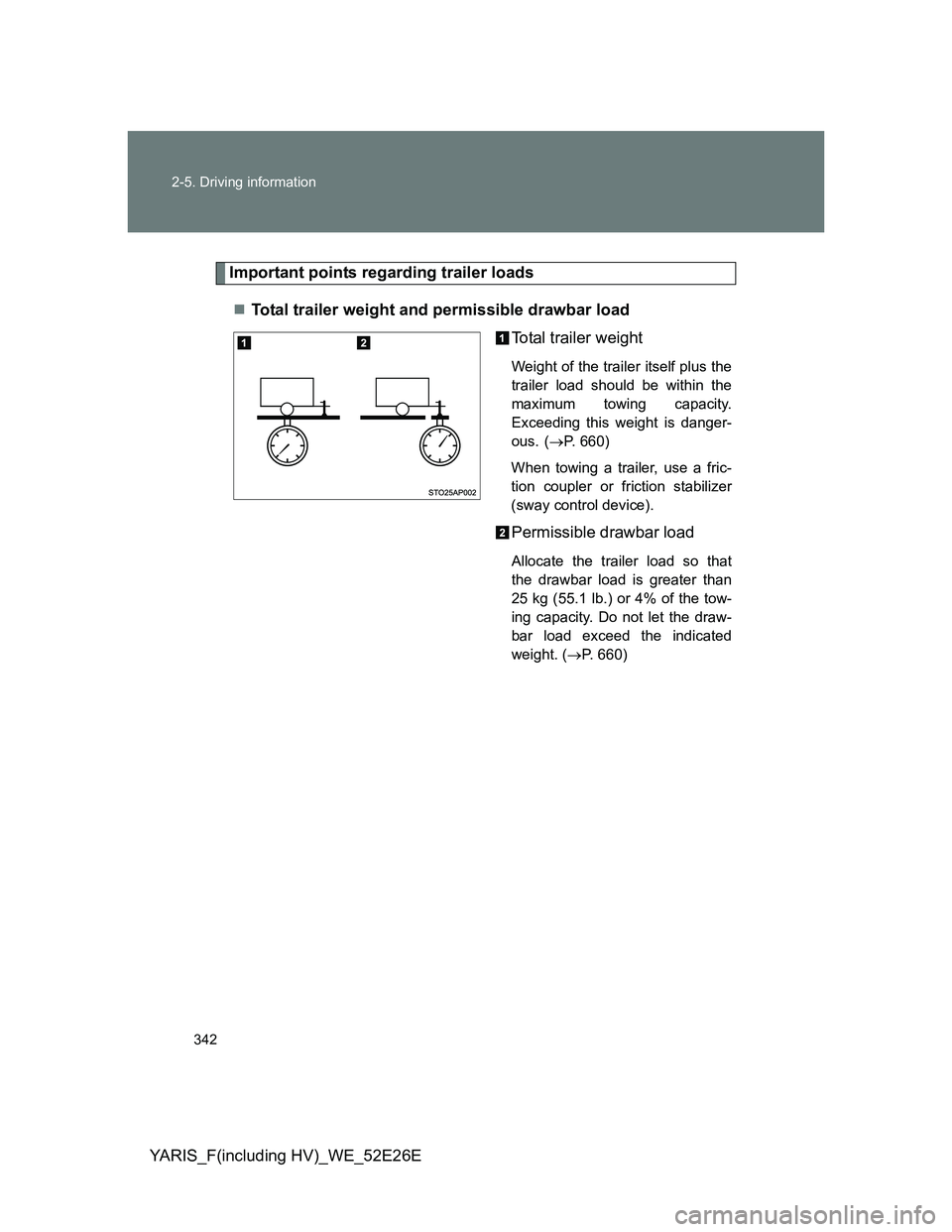
342 2-5. Driving information
YARIS_F(including HV)_WE_52E26E
Important points regarding trailer loads
Total trailer weight and permissible drawbar load
Total trailer weight
Weight of the trailer itself plus the
trailer load should be within the
maximum towing capacity.
Exceeding this weight is danger-
ous.
(P. 660)
When towing a trailer, use a fric-
tion coupler or friction stabilizer
(sway control device).
Permissible drawbar load
Allocate the trailer load so that
the drawbar load is greater than
25 kg (55.1 lb.) or 4% of the tow-
ing capacity. Do not let the draw-
bar load exceed the indicated
weight. (P. 660)
Page 344 of 712
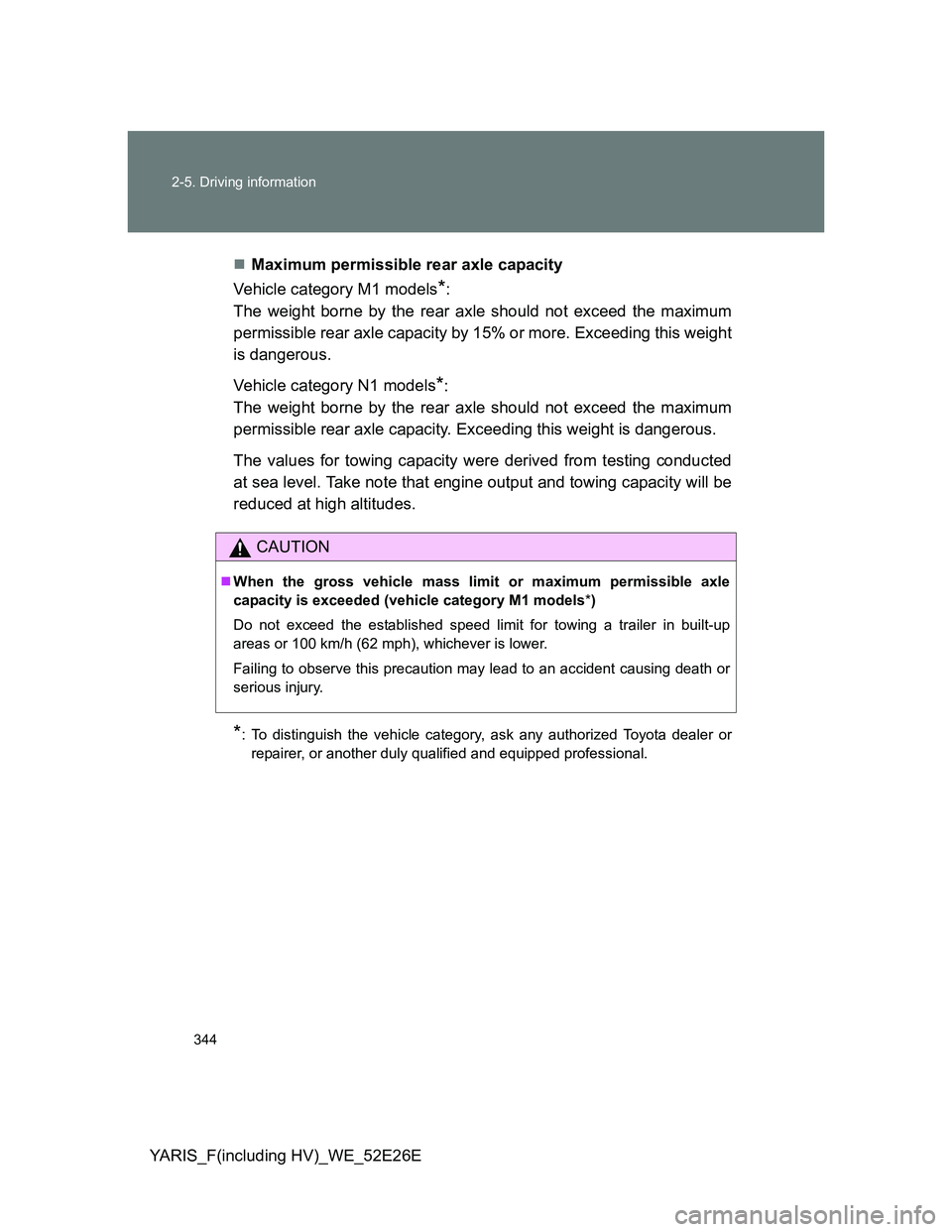
344 2-5. Driving information
YARIS_F(including HV)_WE_52E26EMaximum permissible rear axle capacity
Vehicle category M1 models
*:
The weight borne by the rear axle should not exceed the maximum
permissible rear axle capacity by 15% or more. Exceeding this weight
is dangerous.
Vehicle category N1 models
*:
The weight borne by the rear axle should not exceed the maximum
permissible rear axle capacity. Exceeding this weight is dangerous.
The values for towing capacity were derived from testing conducted
at sea level. Take note that engine output and towing capacity will be
reduced at high altitudes.
*: To distinguish the vehicle category, ask any authorized Toyota dealer or
repairer, or another duly qualified and equipped professional.
CAUTION
When the gross vehicle mass limit or maximum permissible axle
capacity is exceeded (vehicle category M1 models*)
Do not exceed the established speed limit for towing a trailer in built-up
areas or 100 km/h (62 mph), whichever is lower.
Failing to observe this precaution may lead to an accident causing death or
serious injury.
Page 347 of 712
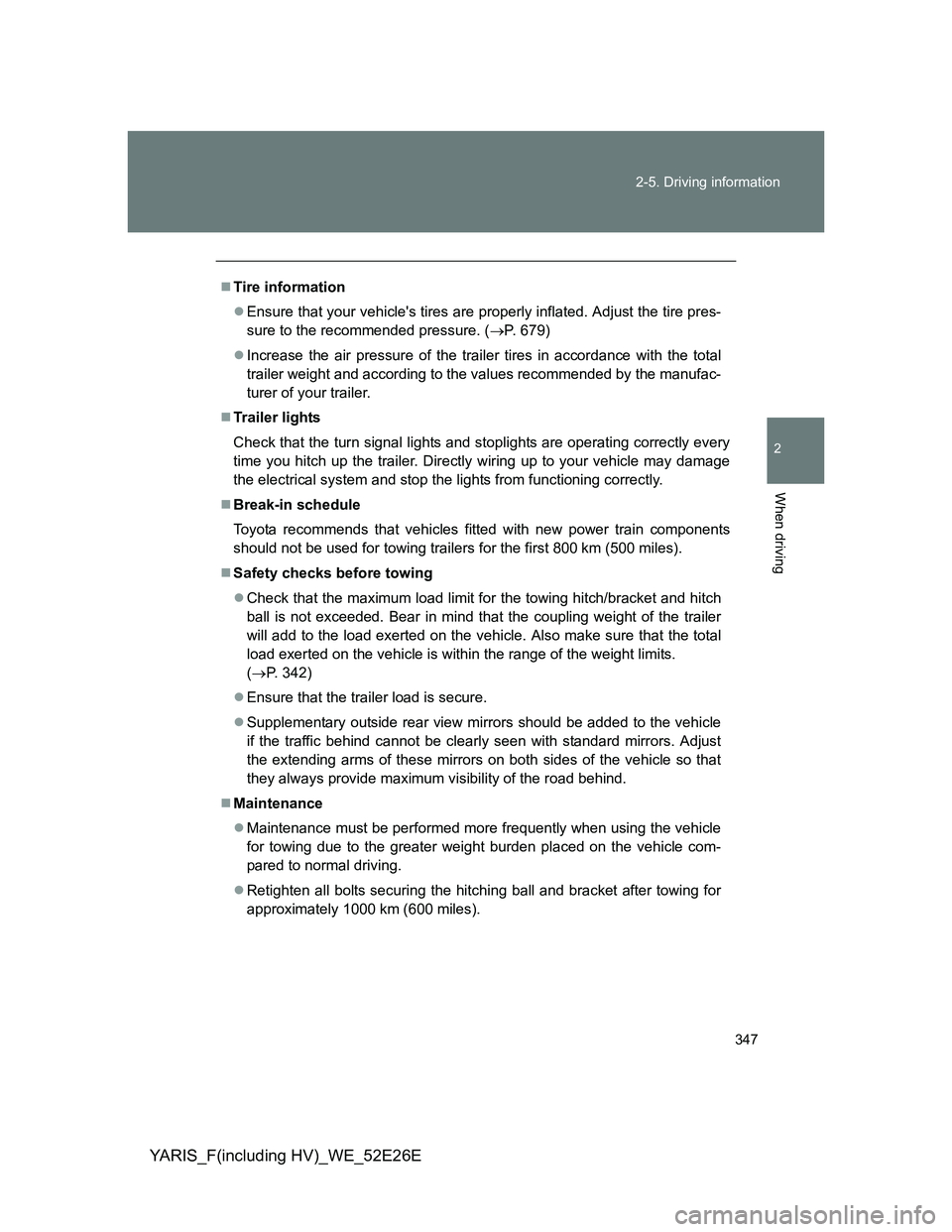
347 2-5. Driving information
2
When driving
YARIS_F(including HV)_WE_52E26E
Tire information
Ensure that your vehicle's tires are properly inflated. Adjust the tire pres-
sure to the recommended pressure. (P. 679)
Increase the air pressure of the trailer tires in accordance with the total
trailer weight and according to the values recommended by the manufac-
turer of your trailer.
Trailer lights
Check that the turn signal lights and stoplights are operating correctly every
time you hitch up the trailer. Directly wiring up to your vehicle may damage
the electrical system and stop the lights from functioning correctly.
Break-in schedule
Toyota recommends that vehicles fitted with new power train components
should not be used for towing trailers for the first 800 km (500 miles).
Safety checks before towing
Check that the maximum load limit for the towing hitch/bracket and hitch
ball is not exceeded. Bear in mind that the coupling weight of the trailer
will add to the load exerted on the vehicle. Also make sure that the total
load exerted on the vehicle is within the range of the weight limits.
(P. 342)
Ensure that the trailer load is secure.
Supplementary outside rear view mirrors should be added to the vehicle
if the traffic behind cannot be clearly seen with standard mirrors. Adjust
the extending arms of these mirrors on both sides of the vehicle so that
they always provide maximum visibility of the road behind.
Maintenance
Maintenance must be performed more frequently when using the vehicle
for towing due to the greater weight burden placed on the vehicle com-
pared to normal driving.
Retighten all bolts securing the hitching ball and bracket after towing for
approximately 1000 km (600 miles).